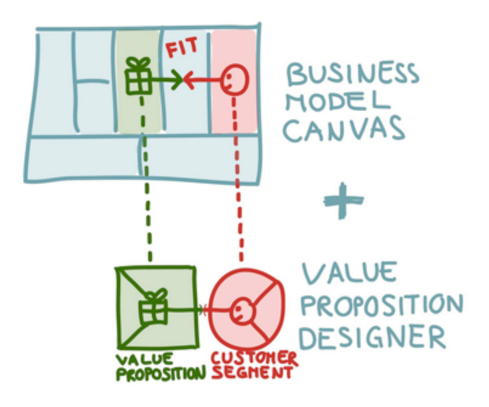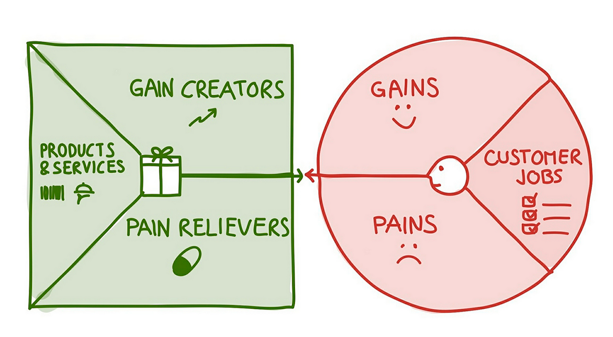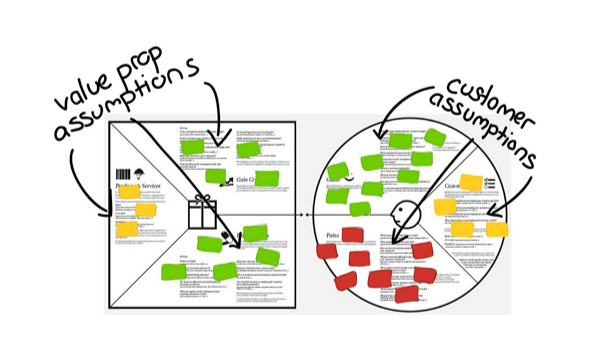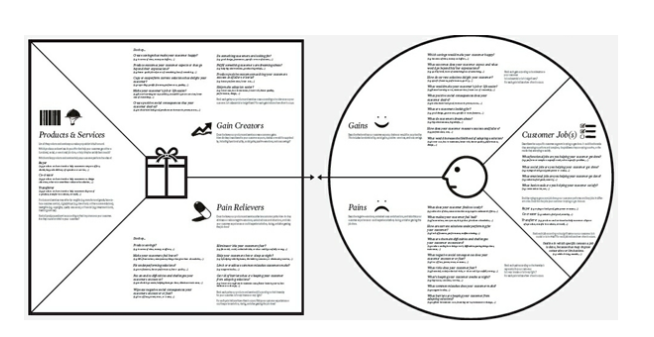VALUE PROPOSITION CANVAS. HOW TO CREATE VALUE PROPOSITIONS?
Accelerate your business with these tips "Value Proposition Canvas: How to create value propositions". Analyse and discover this TIP!
The Value Proposition Canvas is a strategic planning tool that helps companies design, evaluate and improve their value proposition to customers. It consists of two parts: the Customer Profile and the Value Map.
Customer Profiling focuses on understanding the needs, wants and behaviours of the target customer. It identifies the jobs the customer intends to do, the pains or problems they have, and the gains or benefits they seek to achieve. The Value Map focuses on how the company can meet those customer needs. It identifies the products or services that the company offers and how these can alleviate the customer's pains and deliver profits. It also identifies the different elements of the value proposition, such as price, quality, customer service, etc.
By bringing the two parts together, the company gains a complete view of its value proposition to the customer. This allows them to identify opportunities to improve or adjust their offering, and also allows them to clearly communicate their value proposition to customers. Techniques and tools that can be used in conjunction with the Value Proposition Canvas include market segmentation, competitor analysis, SWOT analysis, surveys and focus groups with potential customers, among others.
Practical examples of the Value Proposition canvas
Here are some practical examples of the Value Proposition Canvas:
- Airbnb: Its value proposition is to offer unique and authentic accommodation at an affordable price, connecting travellers with people who have space available for rent.
- Spotify: Its value proposition is to offer access to a wide variety of music and audio content online, personalised and tailored to each user's tastes, without advertising interruptions.
- Tesla: Its value proposition is to offer high quality, state-of-the-art electric vehicles that are sustainable and environmentally friendly, without compromising performance and safety.
- Uber: Its value proposition is to offer a convenient and accessible transport alternative, connecting passengers with drivers in real time, and facilitating cashless payments.
- Apple: Its value proposition is to offer high quality products and innovative design, with an exceptional user experience and a wide range of integrated services.
The Value Proposition Canvas is used to define the value proposition of a company and how it solves the needs and desires of customers in a differential and competitive way in the market.
TO APPLY THE VALUE PROPOSITION CANVAS, AN ENTREPRENEUR SHOULD FOLLOW THE FOLLOWING STEPS:
- Identify customers: you must define who are the potential customers you want to target and what their needs, desires, challenges and problems are.
- Define the value proposition: What is the value proposition to be offered to customers? What problem or need is being solved? What benefits or advantages does the product or service offer?
- Identify products and services: identify the products or services to be offered to customers and how they differ from those offered by competitors.
- Identify distribution channels: the channels through which customers will be reached, whether through physical shops, online shops, social media, etc., should be identified.
- Identify customer relationships: the relationships to be established with customers, be it customer service, technical support, sales promotion, etc., must be established.
- Identify sources of income: the sources of income and how the profitability of the business will be generated must be defined.
- Identify key resources: the resources required for the implementation of the value proposition, such as personnel, technology, infrastructure, etc., should be identified.
- Identify key partners: identify the key partners that will be needed to realise the value proposition, such as suppliers, strategic allies, etc.
- Identify key activities: identify the key activities necessary to realise the value proposition, such as research and development, production, marketing, etc.
- Identify costs: the costs necessary to realise the value proposition and how they will be managed to ensure the profitability of the business must be identified.
In a nutshell, the Value Proposition Canvas is a a useful tool for an entrepreneur to identify customer needs, how they differentiate themselves from the competition and how they will generate revenue from their value proposition.
What is the difference between Value Proposition canvas and empathy map?
The Value Proposition Canvas (VPC) and the Empathy Map are complementary tools used in the product or service design process that help to understand and define the value proposition of a company or brand. Both tools focus on understanding customer needs, wants and problems, but focus on different aspects of the process.
The VPC focuses on creating a value proposition that is relevant and attractive to customers, while at the same time being sustainable for the company. It is divided into two parts: the Customer Profile and the Value Map. The Customer Profile describes who the customers are, what their needs and problems are, and how they interact with the company. The Value Map describes how the company meets those needs and problems with its product or service offering, and how it differentiates itself from the competition.
The Empathy Map, on the other hand, focuses on understanding the emotions and motivations behind customers' needs and problems. It helps to explore and understand the customers' perspective, and to define solutions that are tailored to their needs and desires. It is divided into four quadrants that represent the emotional and rational aspects of customers: what they think, what they feel, what they say and what they do.
In short, the VPC focuses on the value proposition of the company, while the Empathy Map focuses on understanding the emotions and motivations of customers. Both tools are important in the product or service design process, and can be used together to gain a more complete understanding of customers' needs and wants.
What are the differences between the business model canvas and the Value Proposition Canvas?
The Business Model Canvas and the Value Proposition Canvas are two business management tools developed by Alexander Osterwalder and Yves Pigneur. The Business Model Canvas is a tool for defining a company's business model. It consists of nine blocks that describe the key elements of the business, such as customers, distribution channels, revenues and costs, among others. The objective of the Business Model Canvas is to help entrepreneurs and managers to visualise how their company works and to identify areas for improvement.
On the other hand, the Value Proposition Canvas focuses specifically on the value proposition of a product or service. It consists of two blocks: the customer profile and the value proposition. The customer profile describes the needs, wants, behaviours and characteristics of the customers targeted by the product or service. The value proposition describes how the product or service satisfies those customer needs and wants and creates value for them.
The main difference between the two tools is that the Business Model Canvas is a more general tool for the analysis of the company's business model, while the Value Proposition Canvas focuses specifically on the analysis of the value proposition of the product or service offered by the company to its customers.
In summary, the Business Model Canvas is a useful tool for designing a company's business model and the Value Proposition Canvas is a useful tool for designing the value proposition of a product or service.

What kind of information does the Value Proposition Canvas seek to identify?
The Value Proposition Canvas seeks to identify a company's value proposition, i.e. what the company offers and how its product or service solves the needs and problems of its customers. The elements that make up the value proposition are analysed, such as the benefits of the product or service, the target market, the competition and the needs of customers. It also looks at the distribution channels, key activities and resources needed to create and deliver that value proposition.
Case study for the correct application of the Value Proposition Canvas:
Juan is an entrepreneur who wants to launch a new mobile app for exercising at home. To make sure his product is successful, he decides to use the Value Proposition Canvas.
In the Customer Profile section, Juan identifies his ideal customer: men and women aged 25-45 who do not have time to go to the gym and prefer to exercise at home. He also identifies that his ideal customer is concerned about keeping fit and having a healthy lifestyle.
In the "Value Proposition" section, Juan identifies the benefits his app will offer his ideal customer: the ability to exercise at home in an easy and accessible way, personalised workout routines for different skill levels, tracking of user progress and reminders to keep the user motivated and on track.
By using the Value Proposition Canvas, Juan realises that the key to the success of his app is the personalisation of the training routines and the tracking of the user's progress. From there, he can focus his efforts on developing those features and making sure his app is the best choice for his ideal customer. (See+ link).
VALUE PROPOSITION CANVAS, THE VALUE PROPOSITION CANVAS
One of the aspects that generates the greatest uncertainty when we are designing our business model is precisely one of the most important: the value proposition. Being able to find a framework or criteria on which to judge whether what we do makes sense for the customer is critical, but... How to assess it?
THE VALUE PROPOSITION IS THE LINK BETWEEN YOUR PRODUCT AND THE MARKET.
We cannot do the analysis of our value proposition in a vacuum, but it is necessary to take into account the other basic element of any company: the customers... because the success of any business model is due to a good relationship between these two elements, the value proposition and the needs of your customers.

Moreover, the basis for reaching business nirvana, the famous product-market fit (which we already talked about) is precisely that, identifying a product/service (which is your answer to what you believe are the customer's needs and which represents your value proposition) that fits perfectly with a market (defined by a group of customers with specific needs that your product solves).
That said, that's when the cold sweats start: How do I assess whether what I'm doing really makes sense or not? In the end, the answer is simple: "If customers buy your product, it makes sense".
But of course, do I have to wait until I have the finished product? How do I rectify it afterwards? This is where methodologies such as Lean Startup or Customer Development come in... but all of them do little to focus on the initial validation of the value proposition, on the internal analysis of it. Alexander Osterwalder has created an interesting tool for this purpose, the Value Proposition Canvas.
HOW IS THE VALUE PROPOSITION CANVAS USED?
The Value Proposition Canvas is based as mentioned above on matching the needs of your customer segment with your value proposition, and looks like this:

TO UNDERSTAND HOW IT WORKS, THE FIRST THING TO KNOW IS THAT WE ARE GOING TO WORK IN FOUR DISTINCT PHASES:
PHASE 1: OBSERVE
In the first phase, as we have repeated ad nauseam, we must understand the customer's real needs< and for this we have no use for market research or similar tools. The key to understanding what the customer really needs is to observe him.
IDENTIFYING THE "JOBS" YOUR CUSTOMER WANTS TO DO (CUSTOMER JOBS)
Therefore, and establishing certain parallels with the Lean Canvas, it is necessary to identify what problems customers have... but going a little further, and making a real effort to understand your customer's motivations and not just the expressed needs. This is often done by using the concept of the "job to do" or the job that your customer wants to solve by buying your product or service (as we discussed in "Do you understand the job your customer needs?)
For example, we might think that when a customer buys an expensive high-end mobile phone, what he is doing is covering a need to communicate... but what about the social aspects? what about his ego? How does he feel when he uses it? The job he needs to cover is more complex than we thought a priori.
At this point what we need to do is to understand the customer and what moves them (for which we could use the empathy map) and to order by importance (for the customer) the "jobs" that the customer wants to solve. We should also understand the role that the customer wants to adopt in their relationship with our business model (only buy/co-create/be an intermediary...).
IDENTIFYING CUSTOMER FRUSTRATIONS AND JOYS (PAINS and GAINS)
At this point we should make an effort to understand what are the positive aspects or benefits that our client would like to obtain (related to the jobs we have identified)... this includes understanding what alternatives or current solutions they like they are using, for example.
In parallel, we must be able to identify the frustrations and annoyances that make our customer unhappy (including, for example, current solutions that do not satisfy them or aspects that inhibit their consumption, such as price or complexity).
The main objective of the above points is to find a problem worth solving, so we should order the jobs that the customer needs to solve according to aspects such as how frustrated they are, how often they need to solve them, etc. At the end we will have a fairly promising list of what, after observing the clients, we believe are their main needs.
PHASE 2: DESIGN
Instead of doing what we always do, which is to first design something and then see who it can be useful to (if you have felt alluded to, don't worry, it's the usual thing to do), this time we are going to work the other way round: first we have identified a problem that is worth solving (a priori), and then we are going to see how we can solve it.
IDENTIFY THE PRODUCTS OR SERVICES THAT YOU CAN BUILD TO SOLVE THE JOB YOUR CUSTOMER HAS
Now we must focus on identifying the main features or functionalities that our product/service should cover in order to respond to the work that our client needs to solve. This not only implies considering the purely functional aspects but also taking into account, for example, the role that our client wants to adopt and how we can help them in each one.
For example, if our customer wants to adopt a buyer-only role, how do we help them throughout the shopping experience to make the decision to buy our product, to shop in a convenient way...etc.?
ESTABLISH HOW YOUR PRODUCT OR SERVICE HELPS YOUR CUSTOMER
Similar to what we discussed in "Do you sell aspirin, vitamins, vaccines... or Viagra?", we should analyse in which aspects our product or service helps the customer to be happier or feel better (a good design, make their life easier, improve their social perception...), or to alleviate some frustration (save money, pay only for the real use, avoid mistakes...).
The reality is that the process is usually far from simple, and that we will come up with different ways and even different products or services to solve our client's problem. Although it is really more of an art than a science, there are certain criteria (such as the level of frustration they solve, the potential margin, scalability... etc.) that can help us decide on one or the other.
PHASE 3: VALIDATE
AT THIS POINT WHAT WE HAVE ACHIEVED IS TO IDENTIFY MAINLY TWO THINGS:
- Client hypothesis: These are aspects of the business model that are related to what we understand to be the customer's problems, their perception of what they need and what they don't, where to find them, what frustrations they have... etc. This point is given on the right side of the value proposition canvas, and what it basically indicates is that everything we have identified are hypotheses, i.e. ideas about what we believe the customer needs but which are NOT validated.
- Value assumptions: On the other hand, we have the value hypotheses, i.e. those aspects and functionalities of our product or service that we believe will satisfy specific customer needs. They are the left side of the value proposition canvas, and what they tell us is how we have designed our product or service based on what we believe the customer needs (customer hypothesis).

Once the hypotheses have been identified and as we discussed in What hypotheses have you built the future of your company on? and in How to validate the leaps of faith of your business model?, it is time to check in the real world if what we have imagined is true, i.e., if what we have imagined is true: "The time has come to transform hypotheses into certainties".
To do this, what we should do is get out of our office and try to talk to as many customers as we can, trying to validate (or discard) the customer hypotheses we had.
PHASE 4: ADJUST
With everything we found out during the validation process with the customer, we should first update the right-hand side where we had collected the customer hypotheses with what we have learned, and then readjust our value proposition (which will certainly have an impact on the business model we had designed). This implies that we rethink the entire left side of the value proposition canvas in the light of what we have learned from real customers and all the discarded and validated hypotheses.
In all likelihood there will be several important changes. Once this is done, it is time to start building our first prototype, that minimum viable product that will help us validate and adjust the value proposition... but that is something we will expand on in another article.
By the way, the template/poster with which to work on all the above and with guidelines and questions to ask can be found in the poster of the value proposition canvas.

APPLY THIS TIP TO YOUR PROJECT
QUIZ
- 💻 PRACTICE with an expert in the next practical webinar.
- 🔎 CONSULT more related TIPs with this same theme.
- 📖 AMPLIA your knowledge by downloading this EBOOK.
THINK ABOUT YOU
- 🚀 IMPULSA your company in the next acceleration programme, ¡book your place now!
- 🥁 PRACTICE with your project in this practical webinar, ¡apply for your place!.
- 🌐 CONTACT with other entrepreneurs and companies, ¡register and take part in the next Networking!
THINK ABOUT HELPING OTHERS
- 🤝COLLABORATE as a volunteer: expert, mentor, inverter, awarding, Spreading the word, challenging, innovating, creating a TIP...
- 💬 RECOMMENDS this programme to reach out to more entrepreneurs by Google.
- 👉 SHARE your learning!
- 📲 SEND this TIP 👇









